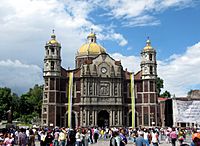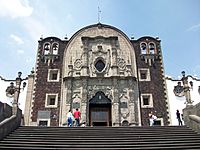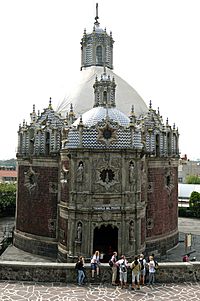Basilica of Our Lady of Guadalupe facts for kids
Quick facts for kids Basilica of Our Lady of Guadalupe |
|
|---|---|
|
Basílica de Nuestra Señora de Guadalupe
|
|
 |
|
| 19°29′2.4″N 99°7′1.2″W / 19.484000°N 99.117000°W | |
| Location | Villa de Guadalupe, Mexico City |
| Country | Mexico |
| Language(s) | Spanish |
| Denomination | Catholic Church |
| History | |
| Status |
|
| Founded | 1709 |
| Dedication | Our Lady of Guadalupe |
| Consecrated | October 12, 1976 |
| Cult(s) present | Our Lady of Guadalupe |
| Architecture | |
| Functional status | Active |
| Architect(s) | José Luis Benlliure |
| Architectural type | Basilica |
| Style | Mexican Baroque |
| Specifications | |
| Capacity | 10,000 (seating) |
| Height | 42 m (138 ft) |
| Number of domes | 1 |
| Dome height (outer) | 100 m (330 ft) |
| Number of towers | 2 |
| Administration | |
| Parish | Our Lady of Guadalupe |
| Deanery | Guadalupana |
| Archdiocese | Mexico |
| Metropolis | Mexico |
| Province | Mexico |
The Basilica of Our Lady of Guadalupe is a famous Catholic Church building in Mexico City. Its official Spanish name is Insigne y Nacional Basílica de Santa María de Guadalupe. The basilica is dedicated to Mary as Our Lady of Guadalupe. It is built at the bottom of Tepeyac Hill.
This is one of the most visited holy places in the world. Every year, about 20 million people, called pilgrims, come to visit. Around December 12, which is the feast day for Our Lady of Guadalupe, about nine million people visit in just a few days.
Contents
The Tepeyac Religious Complex
The Basilica is not just one building, but a large area with several churches and chapels. This area is sometimes called the "Villa de Guadalupe."
The Old Basilica
The church now known as the "Old Basilica" was built a long time ago. Construction started in 1695 and it opened in 1709. The architect was Pedro de Arrieta. It has four towers on its corners and a large dome covered in yellow and blue tiles.
Over time, the building began to sink because the ground underneath it was soft. It had to be repaired and redecorated. The original fancy Baroque style was replaced with a simpler Neoclassical style.
A Bombing in 1921
On November 14, 1921, a bomb hidden in a flower arrangement exploded at the main altar. The explosion damaged the altar steps and stained-glass windows.
However, the original image of the Virgin of Guadalupe was not harmed. A heavy bronze crucifix in front of the image was bent by the blast. Many people believed the crucifix protected the image. This bent crucifix is still on display today.
The New Basilica
Because the Old Basilica was sinking and becoming unsafe, a new, modern basilica was built nearby. Construction started in 1974 and finished in 1976. The architects, including Pedro Ramírez Vázquez and José Luis Benlliure, gave it a circular shape.
The round design means that the famous image of Our Lady of Guadalupe can be seen from anywhere inside. The roof is made of copper that has turned green over time. It was built on special foundations to keep it from sinking like the old church.
To help people see the image up close without causing crowds, there is a moving walkway beneath the altar. Visitors can ride on the conveyor belt to pass in front of the image.
Many important people have visited the New Basilica, including Pope John Paul II five times and Pope Francis in 2016.
Capilla del Cerrito (Chapel on the Hill)
This chapel is on top of Tepeyac Hill. It marks the spot where it is believed that Mary appeared to Saint Juan Diego and where fresh flowers miraculously grew. The first chapel was built here in 1666.
The current building was constructed around 1740. Inside, there are large paintings by Fernando Leal that tell the story of the apparitions.
Capilla del Pocito (Chapel of the Little Well)
This small chapel is near the bottom of Tepeyac Hill. It was built between 1777 and 1791 over a well of water that people believed was miraculous.
To stop the spread of sickness from people drinking the water, a temple was built over the well. The chapel is famous for its unique round shape and is considered a treasure of Baroque architecture.
Other Important Buildings
- Capilla de Indios (Indian Chapel): This was one of the first chapels built on the site, finished in 1649. It was built for the native people to worship. Saint Juan Diego, the man who saw the Virgin, is said to have lived here and his remains are kept in the chapel.
- Tepeyac Pantheon: This is a historic cemetery on Tepeyac Hill, next to the Capilla del Cerrito. It is the resting place of many important figures from Mexican history, including the former president Antonio López de Santa Anna.
- Guadalupe Basilica Museum: Opened in 1941, this museum holds a large collection of religious art from Mexico's colonial period. It has paintings, sculptures, and other valuable items.
Gallery
-
Pocito Chapel in 1888 by Nellie Bly.
Images for kids
-
The crypt of Spanish singer Rocío Dúrcal is located in the basilica.
See also
 In Spanish: Basílica de Santa María de Guadalupe para niños
In Spanish: Basílica de Santa María de Guadalupe para niños
- List of colonial churches in Mexico City
- Mexico City Metropolitan Cathedral
- List of churches under the patronage of Our Lady of Guadalupe
- Rocío Dúrcal, whose final resting place is in this church
- Monastery of Saint Mary of Guadalupe, Extremadura, Spain
- List of Christian pilgrimage sites




























